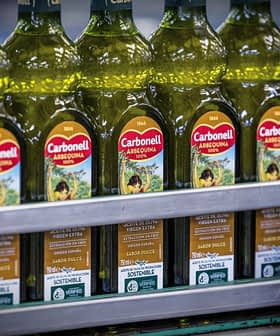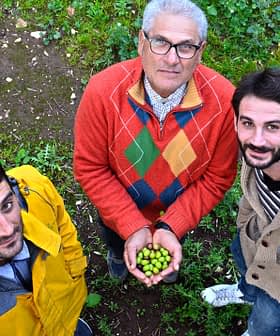Olive Oil-Based Films May Soon Replace Plastic Food Packaging
Researchers in Turkey have developed biodegradable oleofilms, which can prolong the shelf life of perishable foods by slowing oxidation.
New research shows that extra virgin olive oil might be efficiently used as a key component of oleofilms, environmentally friendly food protective coatings.
According to the Turkish researchers who authored the study, these new materials could become a viable alternative to plastics in food packaging.
They decompose quickly in nature and thus do not cause serious environmental pollution. Oleofilms reduce carbon footprint by reducing dependence on fossil fuels.
The researchers developed a simple and effective method to produce oleofilms, bringing the materials one step closer to competing with current industry standards.
“Conventional plastic films are durable for a long time and ensure reliability during transportation and storage,” Bülent Başyiğit, a researcher at the Harran University’s faculty of engineering in Şanlıurfa, Turkey, told Olive Oil Times.
See Also:Olive Milling Byproducts May Improve Animal Feed“Some of their other advantages include being low cost, lightweight, easy to process and having advanced barrier properties,” he added. “However, petroleum-derived conventional plastic films do not biodegrade and remain in nature for a long time.”
“Moreover, harmful chemicals found in the natural structure of the conventional plastic films might leak into the packaged food products or beverages,” Başyiğit noted.
Based on biodegradable and edible oil polymers, oleofilms may have a significant edge over plastics.
“Their most notable features are that they decompose quickly in nature and thus do not cause serious environmental pollution,” Başyiğit said. “Oleofilms reduce carbon footprint by reducing dependence on fossil fuels.”
Typically, plastic films are made from synthetic polymers derived from fossil fuels, such as polyethylene or polypropylene.
In addition, producing such plastic films is a highly energy-intensive process, yet economies of scale have made it significantly cost-effective, unlike most other industrial sectors.
Oleofilms’ key advantages over other biodegradable films are their elasticity and flexibility. They are also far more stable when subjected to extreme temperature changes.
According to the researchers, the chemical structure of oleofilms significantly reduces the risk of chemical leakage into food or drinks.
Oleofilms do not dissolve or break down easily when exposed to moisture, and water does not easily pass through them. “Oleofilms are water-resistant, and their water permeability is low,” Başyiğit confirmed.
“Oleofilms may serve as promising systems for providing protection, particularly for oily and moist food products, since they consist of films made from hydrophobic and oil-based components,” he said.
“These films can prolong the shelf life of foods by preventing oxidation, reducing moisture loss and forming a waterproof barrier,” he added.
Some foods easily packaged with oleofilms include chocolate-based products, cheeses, processed meats and crackers.
In addition, they prove to be highly effective in protecting fresh foods such as fruits and vegetables.
“One primary reason for structural deterioration in fruits and vegetables is water removal from their structures,” Başyiğit said. “Given the hydrophobic nature of oleofilms, they are expected to maintain the moisture balance within the package.”
“Thus, these film models may help prevent shrinkage and hardening by reducing water loss in all fruits and vegetables,” he added. “Natural oils, such as olive oil, possess antimicrobial and anti-fungal properties that help slow food spoilage by inhibiting the growth of bacteria and fungi.”
Extra virgin olive oil is a key component of the oleofilm production method developed by the research team, which has proven more efficient than other biodegradable oils.
“Olive oil provides antioxidative activity to the final product due to the unique structures it contains,” Başyiğit said, hinting at the presence of tocopherols (vitamin E) and phenolic compounds in extra virgin olive oil.
“Their presence in olive oil is crucial for preventing or delaying potential oxidation in films,” he added. “Preventing or delaying oxidative deterioration enhances the lifespan of packaging films.”
Extra virgin olive oil was identified as more efficient than other oils due to its high content of monounsaturated fatty acids, mainly oleic acid, which offers enhanced protection against oxidation compared to polyunsaturated fatty acids.
“Oils rich in saturated and polyunsaturated fatty acids can lead to the hardening or softening of oleofilms,” Başyiğit said. The balanced unsaturated fat content of extra virgin olive oil makes it a more efficient choice.
See Also:Project Turns Olive Waste Into SupercapacitorsPhenols and tocopherols in olive oil reduce oxidative damage, a quality that can be extended by oleofilms coating.
“Incorporating extra virgin olive oil in oleofilms may enhance the antioxidant properties of the final products,” Başyiğit said. “Moreover, antioxidant compounds may protect by diffusing through the film into the food.”
“Films containing olive oil can extend shelf life, preserve nutritional quality and prevent oxidative deterioration by increasing the antioxidant capacity of both the film material and the coated product,” he added.
The presence of extra virgin olive oil in oleofilms further enhances their biodegradability.
“Oleic acid, phenolic compounds and tocopherols in olive oil can enhance biodegradation,” Başyiğit said. “Phenolic compounds can facilitate degradation by increasing enzymatic reactions for microorganisms.”
The olive oil-based oleofilms were produced by combining proteins and lipids using ultrasonic emulsification techniques. The process uses high-frequency sound waves to create and stabilize emulsions, mixtures of two unmixable liquids.
The production began with the preparation of oleogels, which contain soy protein hydrolysate, gelatin, extra virgin olive oil, stearic acid and lecithin.
The protein and lipid phases were mixed in a one-to-one ratio and subjected to high-power sonication, which agitates particles in a fluid through high-frequency sound waves (ultrasound).
This process enhanced the stability and homogeneity of the emulsion. Once the oleogels were formed, they were combined with glycerol to improve flexibility.
After an ultrasonic degassing process to eliminate air bubbles, the mixture was left to dry at room temperature for 24 hours.
The resulting oleofilms, with thicknesses between 0.18 and 0.25 millimeters, proved water-resistant with low gas permeability, meaning that oxygen, carbon dioxide, or water vapor could not easily cross the barrier.
The method identified the necessary ultrasonic power for optimal flexibility, strength and barrier properties, which were successfully tested on freshly cut pineapples.
“In films containing hydrophilic and hydrophobic structures, ultrasonic emulsification is a vital technique that improves film quality by fostering homogeneity,” Başyiğit explained. “It prevents phase separation and enables the creation of mechanically robust and functional films that maintain stability over prolonged periods.”
Researchers warned that more investment and research are needed to support the further development of oleofilms and turn them into a commercially viable alternative to conventional plastic-based films.
The researchers added that significant challenges still need to be addressed.
Oleofilms are more susceptible to tearing than the current industry standard and cannot yet compete in mechanical strength and flexibility. Vacuum packaging is currently not feasible with these new films either.
“Although mass production of plastics is well established and their costs remain very low, oleofilms have yet to achieve economies of scale,” Başyiğit said. “In the long term, if these challenges are overcome, oleofilms could serve as an environmentally friendly alternative.”
The next step for the researchers is to scale up its use in food packaging and explore other possible applications.
“In the long term, the integration of oleofilms into biomedical applications is also possible,” Başyiğit said. “In this context, they might be used in applications like drug delivery systems and wound dressings.”
“However, it is crucial to conduct studies to enhance the thermal and mechanical properties of oleofilms to match those of petroleum-derived films,” he concluded.








